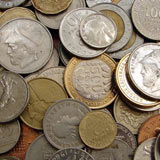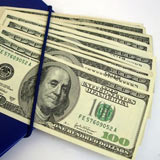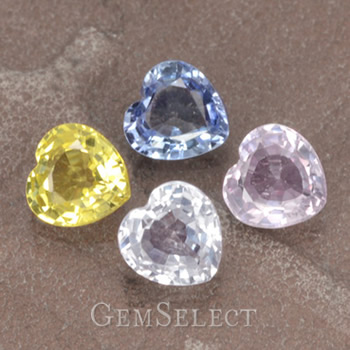Gemstone Prices
 Why does a reasonably nice 1 carat heated sapphire sell for $500 while a fine untreated 6 carat tourmaline goes for $250? Why is a clean untreated 10 carat amethyst only $60? Gemstone prices are puzzling, even to many people in the gem trade. Why does a reasonably nice 1 carat heated sapphire sell for $500 while a fine untreated 6 carat tourmaline goes for $250? Why is a clean untreated 10 carat amethyst only $60? Gemstone prices are puzzling, even to many people in the gem trade.
The simple answer, one would think, is that it's just a matter of supply and demand - if a lot of people want to buy a particular kind of gemstone and the supply is limited, the price for that gemstone will be high. However, that answer doesn't really tell the whole story of how things work in the gemstone business.
 Consider the case of one of the most rare and expensive gemstones, diamond. In the 19th century, world production of diamond was only a few kilograms per year. After the discovery of the huge South African diamond deposits in 1870, diamonds were being dug out of the ground literally by the ton. There was such a large supply and so little demand that the British financiers of the South African mines were in danger of losing their investment. Their solution was to create the powerful De Beers cartel that to this day controls worldwide diamond production and supply. Fine diamonds are actually not scarce at all. But De Beers controls how much supply comes on the market at any one time and that keeps prices high. Consider the case of one of the most rare and expensive gemstones, diamond. In the 19th century, world production of diamond was only a few kilograms per year. After the discovery of the huge South African diamond deposits in 1870, diamonds were being dug out of the ground literally by the ton. There was such a large supply and so little demand that the British financiers of the South African mines were in danger of losing their investment. Their solution was to create the powerful De Beers cartel that to this day controls worldwide diamond production and supply. Fine diamonds are actually not scarce at all. But De Beers controls how much supply comes on the market at any one time and that keeps prices high.
The De Beers consortium also mounted a concerted decades-long advertising campaign to associate diamonds with love, courtship and marriage, under the now familiar slogan "Diamonds are Forever". The diamond engagement ring, once unknown in most parts of the world (including Europe), is now considered an essential part of the ritual of marriage. This was probably one of the most successful feats of social engineering in the 20th century. (However, in Thailand and other parts of the world, a bride still prefers gold, which is liquid in a way that diamonds are not).
 In the colored gemstone world, there is fortunately no cartel, though many forces try to influence market demand and perceived value. According to the International Colored Gemstone Association (ICGA), the "traditional gemstones" - ruby, emerald and blue sapphire - command a high price in the market due to "their lasting appeal and distinguished history". Even though today most of these stones are treated or enhanced in some way, the label "precious" stone adds a hefty premium to the price. In the colored gemstone world, there is fortunately no cartel, though many forces try to influence market demand and perceived value. According to the International Colored Gemstone Association (ICGA), the "traditional gemstones" - ruby, emerald and blue sapphire - command a high price in the market due to "their lasting appeal and distinguished history". Even though today most of these stones are treated or enhanced in some way, the label "precious" stone adds a hefty premium to the price.
The ICGA identifies another category of gems that they call the "new classics" - tanzanite, tourmaline, aquamarine, imperial topaz and tsavorite garnet. These stones are considered "the rising stars of gemstone jewelry" and they are also rising in price as their popularity increases. Tanazanite, in particular, has been very heavily promoted.
Less well-known stones that are not heavily marketed often have very reasonable prices. These stones, which the ICGA calls "collector's gems", include spinel, zircon, moonstone and morganite and some other beryl.
Then there is a list of gems the ICGA calls "affordable gemstones" - nicely colored stones which have good availability and attractive prices. These include amethyst, citrine, ametrine, peridot, rhodolite garnet, blue topaz, iolite, kunzite, diopside and andalusite.
 What all this makes clear, we think, is that there are several factors at work in determining gemstone prices. Supply is of course important, but the marketing power of the jewelry industry is also a major factor in determining the level of demand. If a gemstone is not widely available or not considered mainstream or "fashionable", it is unlikely to be marketed heavily and the price is likely to be lower. If a gemstone has a very good supply, as in the last category, there is not much the jewelry industry can do to influence prices unless they can control the supply like the De Beers cartel. But don't worry, there are no signs yet of a citrine cartel. What all this makes clear, we think, is that there are several factors at work in determining gemstone prices. Supply is of course important, but the marketing power of the jewelry industry is also a major factor in determining the level of demand. If a gemstone is not widely available or not considered mainstream or "fashionable", it is unlikely to be marketed heavily and the price is likely to be lower. If a gemstone has a very good supply, as in the last category, there is not much the jewelry industry can do to influence prices unless they can control the supply like the De Beers cartel. But don't worry, there are no signs yet of a citrine cartel.
So what does this all mean for us? In our view, there are still many good value items available on the gemstone market. In the "precious" stone category, it is still possible to buy nice blue sapphires from Madagascar, Africa and Sri Lanka starting at around $200 per carat. The market for fancy colored sapphire has changed with the introduction of beryllium treatment - there is greater supply and the colors are more dramatic.

Fancy loose Sapphire Hearts from Sri Lanka
Tourmaline may be a "new classic" now, but prices are still attractive and the range of available colors and cuts seem to have increased as tourmaline gets wider distribution. Spinel, with its excellent hardness and clarity, continues to be a great buy. The brilliance of zircon is hard to equal unless you buy diamond. Then there are all the affordable stones still available for less than $10 a carat - wonderful material like garnet, topaz, amethyst, citrine and fire opal.
In the end, the most important thing is that you buy the stones that you love and will enjoy. But if you're looking for the best value, have a look at some of the lesser known gems that haven't yet been heavily marketed. |
